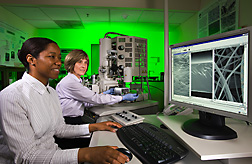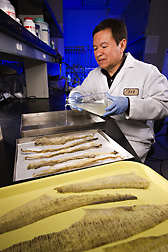Fish Leftovers: New Life Ahead for Today’s Discards?
|
|
Food technologists Cindy Bower and Peter Bechtel spend countless hours up to their elbows in buckets full of aquatic spare parts—fish heads, tails, bones, livers, and more. It’s all known as “fish byproducts,” the leftovers after premium fillets and other edible sections of wild-caught fish are removed and sold.
Harvested from cold waters of the Pacific Ocean, these fish are cleaned and packed in large processing plants in Alaska. Some of those plants are located on the Kodiak Island outpost that serves as the new headquarters for the Agricultural Research Service’s subarctic aquaculture research.
More than half of all wild-caught fish harvested and processed in the United States for human consumption—about 2 million tons—comes from Alaska. But it’s the 1 million tons or so of undervalued bits and pieces of salmon, pollock, cod, and other marine fish that interest Bechtel and Bower.
“Most of the leftovers are ground, dried, and then sold as ingredients for products such as aquaculture feeds or pet foods,” explains Bechtel. “But these leftovers could be directed to higher value uses. That could increase the potential value of Alaska’s fishing industry byproducts by greater than $100 million,” he estimates.
“Our job is to find ways to increase the value of the byproducts,” says Bower.
The researchers have already conducted an array of projects designed to do exactly that, says Bower, who joined lead scientist Bechtel about 6 years ago, when they were based in Fairbanks. Many of the studies were conducted in partnership with scientists from the University of Alaska-Fairbanks as well as with researchers in more than a half dozen other states.
|
|
Low Tech, But High Value
One way Bower hopes to make fish discards more marketable is through smoke-processing. Pink salmon fish heads are rich in oil. “Smoking the fish heads preserves the quality of the oil by delaying oxidation. The process also boosts the antioxidant content of the oil and gives it an appealing, smoky flavor,” she says.
Bower and colleagues described their smoking research in a 2009 article in the Journal of Food Science.
What’s more, she has established a cooperative agreement with scientists at the University of Maine-Orono to explore the possibility of using the aroma-rich oil in foods such as gourmet cheeses.
In other work, Bower and coinvestigators have developed a low-cost, low-tech method for efficiently drying skins of Alaskan pollock. Drying makes the skins lighter and significantly less expensive to ship out of state to factories where they can be used to make gelatin. There is a growing market for fish gelatin among people who don’t eat products made from either pigs or cows—the major sources of gelatin. At present, Alaska doesn’t have any gelatin-processing facilities.
The process that Bower and colleagues developed relies on drying agents, also referred to as “desiccants,” rather than hot air. The desiccants are commonplace, regenerable, and already approved for food use. In tests with pollock skins, the scientists determined the relative efficiency of drying skins for 24 hours using any of four different drying agents. The findings appeared this year in the Journal of Food Science.
|
|
In Hawaii, Fish Say “Aloha” to New Feeds
At the Oceanic Institute in Waimanalo, Hawaii, scientists are collaborating with Bechtel in testing feeds made from Alaska’s fish-processing leftovers. The Hawaii scientists are formulating new and improved feeds for succulent Pacific white shrimp and for Pacific threadfin or “moi,” a delicious white-fleshed species once reserved exclusively for Hawaii’s royalty.
Funded by ARS, scientist Dong-Fang Deng and her colleagues at Waimanalo fashion the fish leftovers into feed pellets. They then characterize the nutrient composition of the feeds, evaluate their ability to attract the shrimp and moi, estimate the feed’s digestibility, and assess the growth of the animals.
Recent tests have shown that many of the Alaska fish parts act as feeding stimulants that, as their name implies, stimulate fish to eat their rations. That occurred in studies with Pacific white shrimp that were fed plant-protein-based feeds to which fish-processing leftovers had been added.
In an earlier ARS-funded study with moi, researcher Ian Forster, formerly at the Oceanic Institute and now at the Canadian Department of Fisheries and Oceans, found that the nutritional quality of feeds made with discarded portions of Alaskan pollock and cod was equivalent to that of feed made from Norwegian fishmeal, generally regarded as the highest standard in the aquaculture feed industry.
An article by Forster and coinvestigators, published in the Journal of the World Aquaculture Society, has details.
In another early investigation—this one with Pacific white shrimp—Forster and colleagues showed that the nutritional quality of feed made with Alaska fish byproducts, mainly pollock, was also comparable to that of Norwegian fishmeal. Their article in the Journal of Aquatic Food Product Technology describes the study.
With further work, Alaska’s fish-processing leftovers may find a niche in Hawaiian aquaculture. Says Deng, “We’re looking at how they fit into our overall objective, which is to develop optimal feeds that are nutritionally balanced, cost effective, and environmentally friendly.”
Fish Gelatin: Ultra-High-Tech Biomedical Uses Ahead?
There’s also a California connection to the Alaska research. Gelatin from the discarded skins of Alaskan pollock may someday be put to intriguing new medical uses, according to ARS chemist Bor-Sen Chiou. He’s developing strong yet pliable sheets, called “films,” made from a blend of the gelatin and a bioplastic called “polylactic acid,” or PLA, from fermented corn sugar.
Chiou is doing the work in conjunction with colleagues in California, where he is based, and with the Alaska team.
The fish- and corn-derived films might in the future be used to produce semi-synthetic tissue to speed repair of injured bone or cartilage, for instance.
Chiou is with the ARS Western Regional Research Center in Albany—near San Francisco. There, in an ultra-high-tech process known as “electrospinning,” the fish gelatin and the PLA are spun together to form slender, submicroscopic fibers. When amassed, these nanofibers form sheets of milky-white film.
At tomorrow’s tissue-engineering labs, the films could be “seeded” with cultures of human cells. The nanofibers would provide a matrix on which the cells could replicate. Later, the tissue resulting from the replicating cells would be used as transplants.
The natural materials that are the basis of the nanofibers—fish and corn—are not expected to pose problems such as allergic reactions. In fact, some of today’s surgically implanted medical devices are made of PLA or contain components made of it.
Chiou, his Alaska colleagues, and his California associates—food engineer Roberto Avena-Bustillos of the University of California-Davis and Albany technicians Haani Jafri and Tina Williams—may be the first to use a blend of fish gelatin and corn-derived plastic to make next-generation nanofibers. It’s a fascinating application of harvests from both land and sea.—By Chris Guy, Stephanie Yao, and Marcia Wood, Agricultural Research Service Information Staff.
This research is part of Aquaculture (#106) and Quality and Utilization of Agricultural Products (#306), two ARS national programs described at www.nps.ars.usda.gov.
Peter J. Bechtel and Cynthia K. Bower are in the USDA-ARS Subarctic Agricultural Research Unit, Fishery Industrial Technology Center, 118 Trident Way, Kodiak, AK 99615; (907) 486-1531 [Bechtel], (907) 486-1534 [Bower].
Bor-Sen Chiou is in the USDA-ARS Bioproduct Chemistry and Engineering Research Unit, Western Regional Research Center, 800 Buchanan St., Albany, CA 94710; (510) 559-5628.
"Fish Leftovers: New Life Ahead for Today’s Discards?" was published in the October 2010 issue of Agricultural Research magazine.









